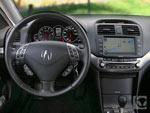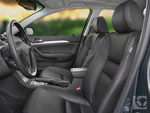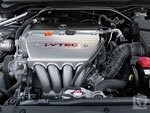 The first time you glanced at the TSX probably didn't feel like it. Even when it was fresh off the boat back in 2004 and had no official predecessor, wasn't there this nagging feeling you'd met before?
The first time you glanced at the TSX probably didn't feel like it. Even when it was fresh off the boat back in 2004 and had no official predecessor, wasn't there this nagging feeling you'd met before?In this case, the déjà vu has multiple dimensions. The first trigger was probably that the TSX wore the exact same face as its big brother, the also-new Acura TL. Any car destined for life in the TL's shadow might also strike a chord for owners of the late Integra sedan, the last car to hold that role. Finally, the TSX just might instill nostalgia among those 3 million Americans who bought a Honda Accord between 1990 and 1997, not all of whom embraced its bigger, more impersonal successors.
But long after our Accord went all gargantuan on us, the rest of Planet Earth kept right on enjoying a slimmer, friskier version of this global staple, possibly marking some missed sales opportunities on our side. What to do? Well, it wouldn't have made much sense to bring back Accord Jr. as-is, but it just so happened that Acura had an opening for a model that could go head-to-head with the world's smaller luxury-sports sedans. So the deal was done and our old friend was reincarnated back into the world - as a higher life form.
Road Test

In a smart decision, the TSX evokes memories of another Acura (to an automotive journalist, anyway) before anything else. As with the TL, the TSX's first impressions are dominated by the aggressive tuning of the primary controls. The accelerator pedal is stiffer than in any competitor, the brakes take a bit more pressure to apply, and the steering wheel involves less hand motion after having its range wound down to 2.7 rotations. Honestly, it's a little unnerving to keep stomping on the gas pedal just to maintain speed and to jump so easily into the next freeway lane, but it's good to see consistency among a car's controls and among Acuras in general.
That consistency pushes the TSX towards the life of an athlete, and its underpinnings give it some further pointers. Honda's long-standing double-wishbone suspensions filling each corner give the TSX the means for good poise and wheel control when sweeping through bends, with slightly firmer valving keeping the body more level and upsized P215/50R17 Michelins providing higher-than-Honda road grip. The TSX's tidy size certainly doesn't hurt any of this, and the ease with which this front-wheel-drive car can rotate its tail is an unexpected delight (or fright, depending on your perspective). The steering doesn't convey as much information as it could and the nose feels as heavy as it is, but on the Acura scale, the TSX is second only to the RSX in handling enjoyment.
The engine is its closest claim to exclusivity. Using the Accord's K-series 4-cylinder as a starting point - and tweaked for 2006 for more airflow on both the intake and exhaust sides - Acura's version cranks out 39 extra horsepower thanks to more compression (9.7 vs. 10.5) and 600 extra revs of breathing room (7,100 RPM). 205 horses is hot stuff for a 2.4-liter block that's been adjusted for sedan duty, and Acura made it sound as rich as a big 4-banger can hope to be. Best of all, even though the iVTEC valve timing is a variable-type system (on the intake side), it still summons a bonus kick in the back at 6,000 RPM like all the happy hyper Hondas.
But do all you want; 2.4 liters is still 2.4 liters, and the TSX's legions of 2.5-to-3.5-liter competitors make its 164 pounds-feet of torque seem a bit wanting. There's just never that feeling of instant punch awaiting your call. This does have a direct reward in fuel economy, of course, which jumps as high as 32 MPG on the freeway and only levels off to 25 (on premium octane) over the course of a week. By a hair, best in class.
The 5-speed automatic compliments the engine well. The Accord's carryover tendency of eager downshifting gets mitigated by the TSX's faster shifts. Another advance is the TSX's exclusive access to SportShift, whose promise of never shifting against your will makes it one of the best manual-override systems out there.
But the TSX couldn't shake all Honda habits. For one thing, even the stiff gas pedal couldn't mask the jumpy throttle calibration that sometimes has you chirping the tires from standing starts. Then there's the worse-than-a-Ford-freakin-Explorer 40-foot turning circle. Lastly, this test car had an engine vibration at idle (when at rest, in Drive) that's most unbecoming of a Honda. Were those counter-rotating balance shafts not working?
Also, some of the [modest] increases in performance took [modest] tolls in comfort. The TSX has the same basically smooth, occasionally choppy ride of the Accord, with a trace more head toss and firmness. Noise suppression is almost as good except for the thinner-and-wider-tired TSX's slightly more acute case of Michelin mayhem. The TSX does have a stiff structure, however - more than the BMW 3-series and Audi A4, says Acura - so at least the shakes never make it past the shocks. In any case, call the TSX's isolation skills solidly good but not quite great.
Come to think of it, call the TSX the same thing.
Inside & Out

Among all the TSX's reported 2006 restylings of the bumpers, grille, side markers and side sills, the only real eye-catchers are the bumper-integrated fog lights and the reforming of the wheels to include a million more spokes. Oh, and the wipers are now more aerodynamically correct. The facelift didn't change the TSX's dimensions, which measure 183.4 inches in length and 69.4 in width while sitting on a wheelbase 105.1 long. By the Acura ruler, that's 5.9, 2.8, and 2.8 inches trimmer than the TL, and by the Honda ruler, a 7.7, 2.2, and 2.8 abbreviation from the Accord.
Aside from the noticeable narrowness, that hardly affects the experience from the first row, a reasonably roomy place with a nice view out the wide, low windows and nicely bolstered seats, with the seat on the left gaining two-position memory for this year. These buttocks found it comfortable on drives of any duration.
You'd think back seat room would take a big penalty over the TL, but the legroom difference is nil, with the only standout, again, being a 2.2-inch cut in shoulder room. That's not to say the TSX's back seat is a comfortable place. Truth be told, I don't know how even two people could stand such unsupportively low cushions and tight toeroom for long, nor I do I know what substance Consumer Reports was abusing the day they rated it "above average."
Strange but true, the TSX's trunk actually holds more than the TL's: a decent 13.2 cubic feet (0.4 less with the nav system), up on 12.5. The 17.1-gallon gas tank is identical to both.
The TSX seems content with its "entry-level luxury" positioning - i.e. only one auto-down window, manual lumbar support, seat heaters but not coolers - and the cheap-feeling lids covering the cupholders and glovebox fall short of luxury altogether. But the leather, dash paddings, and other materials are of upper-middle-class quality and the presentation differs from the TL's just enough to count as its own.
The two share steering wheels and shifters, but the TSX ditched the TL's dominating speedometer for a more traditional twin-gauges setup. The wheel is also a 3-spoker and most of the wannabe aluminum runs horizontally instead of vertically. Finally, the TSX's new trip computer, unfortunately, thought it better to make the driver cycle through four screens instead of simply displaying all pertinent information at once.
It would also have been wiser to copy the TL's main control interface, but the TSX's navigation screen insisted on usurping buttons that should be independent, such as the six radio presets and the meat of the climate control system (fan speed, airflow mode, A/C button). The TL subjects the driver to much less screen switching and even managed to stuff in a tape deck on top of it all.
Otherwise, the TSX would make the family proud. It sure inherited all of the TL's first-rate control logic, meaning adjustments come quickly and meaning it's got the best navigation system on the market. Menus are arranged neatly, the mouse works well, it allows usage while driving (rare), and 2006's faster processor has sped things up noticeably (there's also Zagat restaurant survey access now). And Acura's QWERTY keyboard option makes life so much easier.
The TSX also just got a HandsFreeLink Bluetooth phone interface, and like other Acuras, lets you bark verbal commands at the navigation system. Speaking of toys, the stereo now lets you plug your iPod into an Aux input jack inside the center console (right next to the second 12V power outlet). The stereo may not emblazon a big-name label on the faceplate like other Acuras, but it does boast big-time sound courtesy of 360 watts and eight Pioneer speakers: one in each door, two front tweeters, two back deck 6x9s. If Acura had only bothered to let the CD changer read MP3s, the TSX would trump all others for tech.
Other Thoughts

Once Acura kills off the RSX at the end of the year, the TSX will serve as both the entry point to the brand and to the car's supposed competitive set. This has been made possible by a $28,505 base price, a sum that pays for everything mentioned thus far (and some not mentioned: sunroof, HID headlights, XM radio, six air bags, and a new maintenance minder system) except for the lone option: the $2,000 navigation system. The automatic transmission costs not a cent more than the slick-shifting manual - good news for the majority.
At face value, it all sounds perfectly inviting. But when Acura starts dropping names like BMW 3-series and Audi A4 and lays claim to the TSX having "outstanding road feel that rivals the best Europe can offer," we have to halt this mostly celebratory review to slap some reality into the slanderers.
Those could not be called wisely chosen battles. The 3-series in particular can mop any mountain road with the TSX: its tires hang on longer, its communication skills and balanced 50:50 weight distribution put it in another league of fun, and even Acura's best effort with a big 4-cylinder can't compare to a BMW straight six in power or feel. A base 325i wastes the TSX to 60 by more than a second and has a lot more fun in the process, and the list goes on. You could also take this paragraph and substitute the word "BMW" with "Infiniti" or "Lexus" or "Mercedes", because only one contestant was naïve enough to step into the ring with front-wheel-drive and four flaky cylinders. Acura.
Sure, you could argue that the finishing gap isn't all that vast. But the very point of stepping up to the luxury class - or at least the legitimacy behind the idea - is to have the real thing, to be one tangible step above the masses. Otherwise, what does that brand name represent?
The TSX's only defense is that Acura gives a fair discount to compensate for its transgressions, but is that even true? There are other sophisticated, 4-cylinder, front-wheel-drive compact sedans out there; they wear names like Mitsubishi Lancer Ralliart and Mazda 3 s and carry prices of about $8,000 to the south. Alternately, imagine if Honda offered their 197-horsepower Civic Si in 4-door form: we'd have a faster, 400-pounds-lighter alternative ready for the taking at $20,840. Sure, the TSX deserves some credit for its double-wishbone front suspension, leather seats, and rockin Pioneer speakers. But unless we get seriously creative with our accounting here, the TSX is at least $5,000 over the hill. [source : automotive.com]
Post a Comment